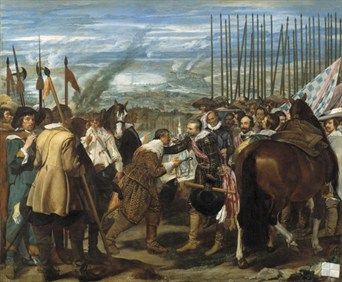Thirty Years’ War
 The Thirty Years’ War owes its name to the duration of a conflict which took place primarily in Germany and Bohemia in the first half of the seventeenth century (1618-1648), but which also took place in northern Italy. The intricate political situation that followed the religious Peace of Augsburg of 1555 became further complicated when the Emperor Matthias of Habsburg (1557-1619) disregarded the Letter of Majesty in which his brother and predecessor Rudolph II (1576-1612) had granted in 1609 liberty of conscience to the subjects of the kingdom of Bohemia. The limitations imposed by Matthias on Calvinist worship and the appointment as his successor of a uncompromising Catholic like Duke Ferdinand of Styria (1578-1637), provoked an uprising in the city of Prague (23 May 1618) and the famous “defenestration”. Rioters stormed the castle and threw the two imperial representatives who were there out of the window. After the death of Matthias of Habsburg, the Bohemians refused to recognize the designated heir and conferred the crown upon Frederick V, the Elector Palatine (1596-1632), the head of the Evangelical Union. Thus began the Thirty Years’ War. The first historic battle took place on the White Mountain (1620, near Prague), where the imperial troops, backed by the Catholic League and the infantry of the Spanish Habsburgs, defeated the Bohemian and Palatine forces. Having reconquered Bohemia, where the victors imposed Catholicism with brutality and violence, the Spanish-Imperial army also invaded the Palatinate. At this point, fearful of the European expansion of the Habsburgs and the emergence of Catholic hegemony that would crush other religions, other Protestant powers took the field: the Swiss Confederation (1620-1630), Denmark (1625-1629) and Lutheran Sweden (1629-1635). Despite all this, however, the Habsburgs continued to fare better. The tide of the war changed only when France, which in previous years had limited itself to financially supporting the Protestants, decided to take to the field with an army, and finally defeated the Spaniards at Rocroi (1643). The negotiations produced two treaties, signed in Münster and Osnabrück, respectively, that have gone down in history as the Peace of Westphalia (24 October 1648). The conflict continued on a small scale only between Spain and France, until the defeat of the Spanish troops at the Battle of the Dunes (1658) and the signing of the peace treaty of the Pyrenees (1659). The Thirty Years’ War marked the decline of the hegemonic designs of Habsburg Austria and Spain (which were forced to recognize the independence of the United Provinces), in religious, political and military matters, the weakening of imperial power over Germany and recognition of the Calvinist faith as on par with other Protestant denominations. The Peace of Westphalia, also recognized the role of Switzerland and Sweden as regional powers.
The Thirty Years’ War owes its name to the duration of a conflict which took place primarily in Germany and Bohemia in the first half of the seventeenth century (1618-1648), but which also took place in northern Italy. The intricate political situation that followed the religious Peace of Augsburg of 1555 became further complicated when the Emperor Matthias of Habsburg (1557-1619) disregarded the Letter of Majesty in which his brother and predecessor Rudolph II (1576-1612) had granted in 1609 liberty of conscience to the subjects of the kingdom of Bohemia. The limitations imposed by Matthias on Calvinist worship and the appointment as his successor of a uncompromising Catholic like Duke Ferdinand of Styria (1578-1637), provoked an uprising in the city of Prague (23 May 1618) and the famous “defenestration”. Rioters stormed the castle and threw the two imperial representatives who were there out of the window. After the death of Matthias of Habsburg, the Bohemians refused to recognize the designated heir and conferred the crown upon Frederick V, the Elector Palatine (1596-1632), the head of the Evangelical Union. Thus began the Thirty Years’ War. The first historic battle took place on the White Mountain (1620, near Prague), where the imperial troops, backed by the Catholic League and the infantry of the Spanish Habsburgs, defeated the Bohemian and Palatine forces. Having reconquered Bohemia, where the victors imposed Catholicism with brutality and violence, the Spanish-Imperial army also invaded the Palatinate. At this point, fearful of the European expansion of the Habsburgs and the emergence of Catholic hegemony that would crush other religions, other Protestant powers took the field: the Swiss Confederation (1620-1630), Denmark (1625-1629) and Lutheran Sweden (1629-1635). Despite all this, however, the Habsburgs continued to fare better. The tide of the war changed only when France, which in previous years had limited itself to financially supporting the Protestants, decided to take to the field with an army, and finally defeated the Spaniards at Rocroi (1643). The negotiations produced two treaties, signed in Münster and Osnabrück, respectively, that have gone down in history as the Peace of Westphalia (24 October 1648). The conflict continued on a small scale only between Spain and France, until the defeat of the Spanish troops at the Battle of the Dunes (1658) and the signing of the peace treaty of the Pyrenees (1659). The Thirty Years’ War marked the decline of the hegemonic designs of Habsburg Austria and Spain (which were forced to recognize the independence of the United Provinces), in religious, political and military matters, the weakening of imperial power over Germany and recognition of the Calvinist faith as on par with other Protestant denominations. The Peace of Westphalia, also recognized the role of Switzerland and Sweden as regional powers.
Read more :
-
G. Parker, The Thirty Years’ War, London 1984.
-
P.H. Wilson, Europe’s Tragedy. A History of the Thirty Years War, London 2009.
